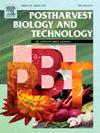沉默 Sly-miR159 可加速番茄果实的采前成熟和采后衰老
IF 6.4
1区 农林科学
Q1 AGRONOMY
引用次数: 0
摘要
miR159是一种古老而高度保守的微RNA(miRNA),在各种组织和发育阶段中频繁表达,并通过调控多个靶基因广泛参与植物生长。本研究通过农杆菌介导转化法获得了短串联靶标模拟沉默miR159(STM-miR159)和过表达miR159(OE-miR159)的番茄品系。结果表明,OE-miR159通过降低SlMYB120的表达水平导致雄性不育并诱导孤雌生殖。STTM-miR159 通过提高 SlACS8 的表达水平加速番茄果实的采前成熟。STTM-miR159 通过影响乙烯信号通路,减少了类胡萝卜素的积累,延缓了番茄果实采后的衰老。该研究拓展了miR159-SlACS8/SlMYB120模块在番茄果实生育性状、成熟和衰老中的功能认知。本文章由计算机程序翻译,如有差异,请以英文原文为准。
Silencing Sly-miR159 accelerated preharvest ripening and delayed postharvest senescence of tomato fruit
The miR159 is an ancient and highly conserved microRNA (miRNA), which is frequently expressed in various tissues and developmental phases, as well as participated extensively in plant growth by regulating multiple target genes. In the present study, the tomato lines of silencing-miR159 by short tandem target mimic (STTM-miR159) and overexpression-miR159 (OE-miR159) were obtained by Agrobacterium-mediated transformation. The results showed that the OE-miR159 caused male sterility and induced parthenocarpy by decreasing the expression level of SlMYB120. The STTM-miR159 accelerated the preharvest ripening of tomato fruit by increasing the expression level of SlACS8. The STTM-miR159 reduced the accumulation of carotenoids and delayed the postharvest senescence of tomato fruit by affecting the ethylene signaling pathway. This study expanded the cognition of function of miR159-SlACS8/SlMYB120 module in fertility traits, ripening and senescence of tomato fruit.
求助全文
通过发布文献求助,成功后即可免费获取论文全文。
去求助
来源期刊

Postharvest Biology and Technology
农林科学-农艺学
CiteScore
12.00
自引率
11.40%
发文量
309
审稿时长
38 days
期刊介绍:
The journal is devoted exclusively to the publication of original papers, review articles and frontiers articles on biological and technological postharvest research. This includes the areas of postharvest storage, treatments and underpinning mechanisms, quality evaluation, packaging, handling and distribution of fresh horticultural crops including fruit, vegetables, flowers and nuts, but excluding grains, seeds and forages.
Papers reporting novel insights from fundamental and interdisciplinary research will be particularly encouraged. These disciplines include systems biology, bioinformatics, entomology, plant physiology, plant pathology, (bio)chemistry, engineering, modelling, and technologies for nondestructive testing.
Manuscripts on fresh food crops that will be further processed after postharvest storage, or on food processes beyond refrigeration, packaging and minimal processing will not be considered.
 求助内容:
求助内容: 应助结果提醒方式:
应助结果提醒方式:


